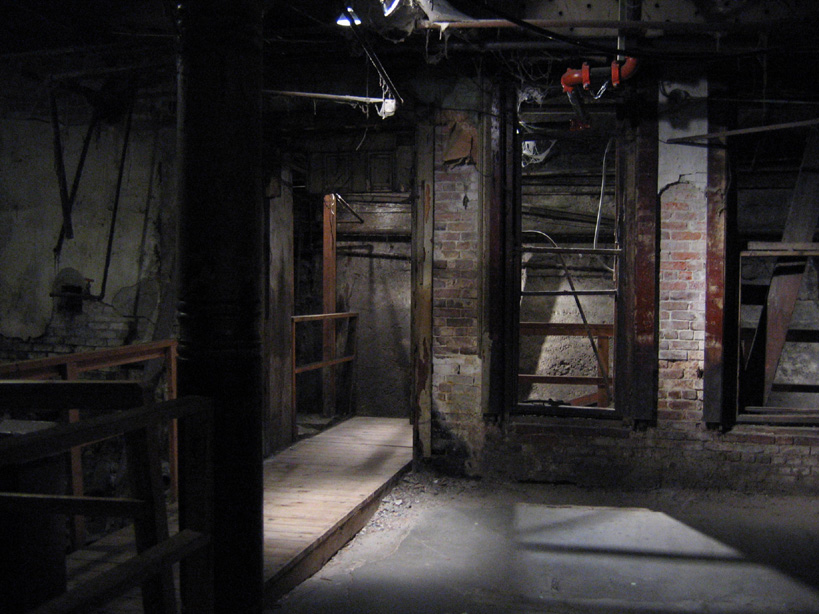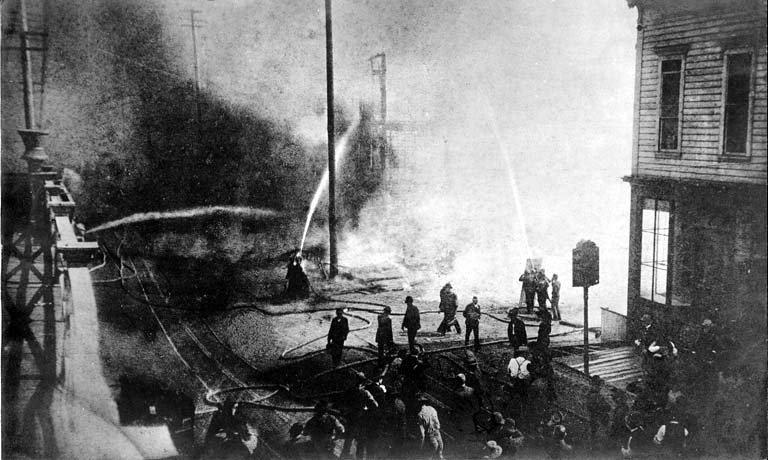Seattle Underground on:
[Wikipedia]
[Google]
[Amazon]
 The Seattle Underground is a network of underground passageways and basements in the Pioneer Square neighborhood of
The Seattle Underground is a network of underground passageways and basements in the Pioneer Square neighborhood of

 After the Great Seattle Fire of June 6, 1889, new construction was required to be of masonry, and the town's streets were regraded one to two
After the Great Seattle Fire of June 6, 1889, new construction was required to be of masonry, and the town's streets were regraded one to two  When they reconstructed their buildings, merchants and landlords knew that the ground floor would eventually be underground and the next floor up would be the new ground floor, so there is very little decoration on the doors and windows of the original ground floor, but extensive decoration on the new ground floor.
Once the new sidewalks were complete, building owners moved their businesses to the new ground floor, although merchants carried on business in the lowest floors of buildings that survived the fire, and pedestrians continued to use the underground
When they reconstructed their buildings, merchants and landlords knew that the ground floor would eventually be underground and the next floor up would be the new ground floor, so there is very little decoration on the doors and windows of the original ground floor, but extensive decoration on the new ground floor.
Once the new sidewalks were complete, building owners moved their businesses to the new ground floor, although merchants carried on business in the lowest floors of buildings that survived the fire, and pedestrians continued to use the underground
Mashable: 1905-1930 The Seattle Regrade
{{Man-made and man-related Subterranea Underground Tourist attractions in Washington (state) Underground cities
 The Seattle Underground is a network of underground passageways and basements in the Pioneer Square neighborhood of
The Seattle Underground is a network of underground passageways and basements in the Pioneer Square neighborhood of Seattle, Washington
Seattle ( ) is a seaport city on the West Coast of the United States. It is the seat of King County, Washington. With a 2020 population of 737,015, it is the largest city in both the state of Washington and the Pacific Northwest region ...
, United States. They were located at ground level when the city was built in the mid-19th century but fell into disuse after the streets were elevated. In recent decades, they have become a tourist attraction, with guided tours taking place around the area.
History

stories
Story or stories may refer to:
Common uses
* Story, a narrative (an account of imaginary or real people and events)
** Short story, a piece of prose fiction that typically can be read in one sitting
* Story (American English), or storey (Briti ...
higher. Pioneer Square had originally been built mostly on filled-in tidelands and often flood
A flood is an overflow of water ( or rarely other fluids) that submerges land that is usually dry. In the sense of "flowing water", the word may also be applied to the inflow of the tide. Floods are an area of study of the discipline hydrol ...
ed. The new street level also kept sewers draining into Elliott Bay
Elliott Bay is a part of the Central Basin region of Puget Sound. It is in the U.S. state of Washington, extending southeastward between West Point in the north and Alki Point in the south. Seattle was founded on this body of water in the 1850s ...
from backing up at high tide
Tides are the rise and fall of sea levels caused by the combined effects of the gravitational forces exerted by the Moon (and to a much lesser extent, the Sun) and are also caused by the Earth and Moon orbiting one another.
Tide tables c ...
.
For the regrade, the streets were lined with concrete walls that formed narrow alleyways between the walls and the buildings on both sides of the street, with a wide "alley" where the street was. The naturally steep hillsides were used and, through a series of sluice
Sluice ( ) is a word for a channel controlled at its head by a movable gate which is called a sluice gate. A sluice gate is traditionally a wood or metal barrier sliding in grooves that are set in the sides of the waterway and can be considered ...
s, material was washed into the wide "alleys", by raising the streets to the desired new level, generally higher than before, in some places nearly .
At first, pedestrians climbed ladders to go between street level and the sidewalks in front of the building entrances. Brick archways were constructed next to the road surface, above the submerged sidewalks. Vault lights (a form of walk-on skylight with small panes of clear glass which later became amethyst-colored) were installed over the gap from the raised street and the building, creating the area now called the Seattle Underground.
 When they reconstructed their buildings, merchants and landlords knew that the ground floor would eventually be underground and the next floor up would be the new ground floor, so there is very little decoration on the doors and windows of the original ground floor, but extensive decoration on the new ground floor.
Once the new sidewalks were complete, building owners moved their businesses to the new ground floor, although merchants carried on business in the lowest floors of buildings that survived the fire, and pedestrians continued to use the underground
When they reconstructed their buildings, merchants and landlords knew that the ground floor would eventually be underground and the next floor up would be the new ground floor, so there is very little decoration on the doors and windows of the original ground floor, but extensive decoration on the new ground floor.
Once the new sidewalks were complete, building owners moved their businesses to the new ground floor, although merchants carried on business in the lowest floors of buildings that survived the fire, and pedestrians continued to use the underground sidewalk
A sidewalk (North American English), pavement (British English), footpath in Australia, India, New Zealand and Ireland, or footway, is a path along the side of a street, highway, terminals. Usually constructed of concrete, pavers, brick, stone ...
s lit by the vault lights (still seen on some streets) embedded in the grade-level sidewalk above.
In 1907, the city condemned the Underground for fear of bubonic plague
Bubonic plague is one of three types of plague caused by the plague bacterium ('' Yersinia pestis''). One to seven days after exposure to the bacteria, flu-like symptoms develop. These symptoms include fever, headaches, and vomiting, as wel ...
, two years before the 1909 World Fair in Seattle ( Alaska-Yukon-Pacific Exposition). The basements were left to deteriorate or were used as storage. Some became illegal flophouses for the homeless
Homelessness or houselessness – also known as a state of being unhoused or unsheltered – is the condition of lacking stable, safe, and adequate housing. People can be categorized as homeless if they are:
* living on the streets, also kn ...
, gambling
Gambling (also known as betting or gaming) is the wagering of something of value ("the stakes") on a random event with the intent of winning something else of value, where instances of strategy are discounted. Gambling thus requires three ele ...
halls, speakeasies
A speakeasy, also called a blind pig or blind tiger, is an illicit establishment that sells alcoholic beverages, or a retro style bar that replicates aspects of historical speakeasies.
Speakeasy bars came into prominence in the United States ...
, and opium dens.
Tours
Only a small portion of the Seattle Underground has been restored and made safe and accessible to the public on guided tours. In 1965, local citizen Bill Speidel formally created "Bill Speidel's Underground Tour", which continues to operate from the Pioneer Building and adjacent buildings. The tour route passes disused storefronts, artifacts, and multiple tunnel entrances. A second tour, Beneath the Streets, was created in 2013 and uses other sections of the Underground network.See also
* Catacombs of Paris *Catacombs of Rome
The Catacombs of Rome ( it, Catacombe di Roma) are ancient catacombs, underground burial places in and around Rome, of which there are at least forty, some rediscovered only in recent decades. Though most famous for Christian burials, either ...
* Edinburgh Vaults
The Edinburgh Vaults or South Bridge Vaults are a series of chambers formed in the nineteen arches of the South Bridge in Edinburgh, Scotland, was part of the South Bridge Act 1785 and was completed in 1788. For around 30 years, the vaults we ...
* Mary King's Close
* Manchester Cathedral Steps
* Raising of Chicago
* Shanghai tunnels (less commonly known as the Portland Underground, in Portland, Oregon
Portland (, ) is a port city in the Pacific Northwest and the largest city in the U.S. state of Oregon. Situated at the confluence of the Willamette and Columbia rivers, Portland is the county seat of Multnomah County, the most populous ...
)
* Underground Atlanta
* Underground City, Montreal
RÉSO, commonly referred to as the Underground City (french: La ville souterraine), is the name applied to a series of interconnected office towers, hotels, shopping centres, residential and commercial complexes, convention halls, universities an ...
, modern construction of interconnected office buildings, hotels, shopping centers and other venues in Montreal
Montreal ( ; officially Montréal, ) is the second-most populous city in Canada and most populous city in the Canadian province of Quebec. Founded in 1642 as '' Ville-Marie'', or "City of Mary", it is named after Mount Royal, the triple- ...
's CBD
* Underground City
An underground city is a series of linked subterranean spaces that may provide a defensive refuge; a place for living, working or shopping; a transit system; mausolea; wine or storage cellars; cisterns or drainage channels; or several of th ...
(underground features in cities around the world)
References
Further reading
* *External links
*Mashable: 1905-1930 The Seattle Regrade
{{Man-made and man-related Subterranea Underground Tourist attractions in Washington (state) Underground cities